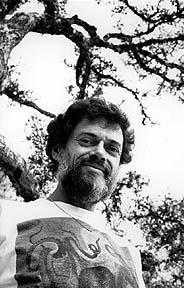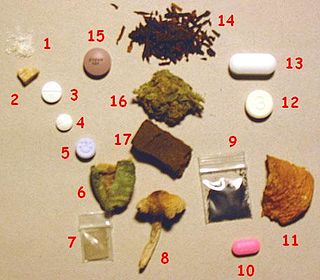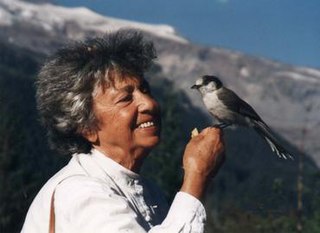
3,4-Methylenedioxymethamphetamine (MDMA), commonly known as ecstasy, and molly, is a empathogen–entactogen with stimulant and minor psychedelic properties. In studies, it has been used alongside psychotherapy in the treatment of post-traumatic stress disorder (PTSD) and social anxiety in autism spectrum disorder. The purported pharmacological effects that may be prosocial include altered sensations, increased energy, empathy, and pleasure. When taken by mouth, effects begin in 30 to 45 minutes and last three to six hours.

Alexander Theodore "Sasha" Shulgin was a Berkeley-trained American biochemist, broad researcher of synthetic psychoactive compounds, and author of works regarding these, who independently explored the organic chemistry and pharmacology of such agents—in his mid-life and later, many through preparation in his home laboratory, and testing on himself. He is acknowledged to have introduced to broader use, in the late 1970s, the prior synthesized compound, MDMA ("ecstasy"), recreationally and in research psychopharmacology, the latter through presentations and academic publications, including to psychologists; and for the rediscovery, occasional discovery, and regular synthesis and personal use and distribution, possibly of hundreds of psychoactive compounds. As such, Shulgin is seen both as a pioneering and a controversial participant in the emergence of the broad use of psychedelics.

Alfred Rupert Sheldrake is an English author and parapsychology researcher. He proposed the concept of morphic resonance, a conjecture that lacks mainstream acceptance and has been widely criticized as pseudoscience. He has worked as a biochemist at Cambridge University, a Harvard scholar, a researcher at the Royal Society, and a plant physiologist for ICRISAT in India.

Ralph Herman Abraham is an American mathematician. Since 1968, he has been a member of the faculty of the University of California, Santa Cruz, where he is currently professor emeritus of mathematics.

Terence Kemp McKenna was an American ethnobotanist and mystic who advocated for the responsible use of naturally occurring psychedelic plants. He spoke and wrote about a variety of subjects, including psychedelic drugs, plant-based entheogens, shamanism, metaphysics, alchemy, language, philosophy, culture, technology, ethnomycology, environmentalism, and the theoretical origins of human consciousness. He was called the "Timothy Leary of the '90s", "one of the leading authorities on the ontological foundations of shamanism", and the "intellectual voice of rave culture".

Entheogens are psychoactive substances, including psychedelic drugs, used in sacred contexts in religion for inducing spiritual development throughout history.

Empathogens or entactogens are a class of psychoactive drugs that induce the production of experiences of emotional communion, oneness, relatedness, emotional openness—that is, empathy or sympathy—as particularly observed and reported for experiences with 3,4-methylenedioxymethamphetamine (MDMA). This class of drug is distinguished from the classes of hallucinogen or psychedelic, and amphetamine or stimulants. Major members of this class include MDMA, MDA, MDEA, MDOH, MBDB, 5-APB, 5-MAPB, 6-APB, 6-MAPB, methylone, mephedrone, GHB, αMT, and αET, MDAI among others. Most entactogens are phenethylamines and amphetamines, although several, such as αMT and αET, are tryptamines. When referring to MDMA and its counterparts, the term MDxx is often used. Entactogens are sometimes incorrectly referred to as hallucinogens or stimulants, although many entactogens such as ecstasy exhibit psychedelic or stimulant properties as well.

Erowid, also called Erowid Center, is a non-profit educational organization that provides information about psychoactive plants and chemicals.
The Institute of Noetic Sciences (IONS) is an American non-profit parapsychological research institute. It was co-founded in 1973 by former astronaut Edgar Mitchell, the sixth man to walk on the Moon, along with investor Paul N. Temple and others interested in purported paranormal phenomena, in order to encourage and conduct research on noetics and human potentials.

Psychonautics refers both to a methodology for describing and explaining the subjective effects of altered states of consciousness, including those induced by meditation or mind-altering substances, and to a research cabal in which the researcher voluntarily immerses themselves into an altered mental state in order to explore the accompanying experiences.

David Earl Nichols is an American pharmacologist and medicinal chemist. Previously the Robert C. and Charlotte P. Anderson Distinguished Chair in Pharmacology at Purdue University, Nichols has worked in the field of psychoactive drugs since 1969. While still a graduate student, he patented the method that is used to make the optical isomers of hallucinogenic amphetamines. His contributions include the synthesis and reporting of escaline, LSZ, 6-APB, 2C-I-NBOMe and other NBOMe variants, and several others, as well as the coining of the term "entactogen".

5-MeO-MiPT is a psychedelic and hallucinogenic drug, used by some as an entheogen. It has structural and pharmacodynamic properties similar to the drugs 5-MeO-DiPT, DiPT, and MiPT. It is commonly used as a "substitute" for 5-MeO-DiPT because of the very similar structure and effects.
An oneirogen, from the Greek ὄνειρος óneiros meaning "dream" and gen "to create", is a substance or other stimulus which produces or enhances dreamlike states of consciousness. This is characterized by an immersive dream state similar to REM sleep, which can range from realistic to alien or abstract.
The Beckley Foundation is a UK-based think tank and UN-accredited NGO, dedicated to activating global drug policy reform and initiating scientific research into psychoactive substances. The foundation is a charitable trust which collaborates with leading scientific and political institutions worldwide to design and develop research and global policy initiatives. It also investigates consciousness and its modulation from a multidisciplinary perspective, working in collaboration with scientists. The foundation is based at Beckley Park near Oxford, United Kingdom. It was founded in 1998, and is directed by Amanda Feilding, Countess of Wemyss.

A drug is any chemical substance other than a nutrient or an essential dietary ingredient, which, when administered to a living organism, produces a biological effect. Consumption of drugs can be via inhalation, injection, smoking, ingestion, absorption via a patch on the skin, suppository, or dissolution under the tongue.
Substituted amphetamines are a class of compounds based upon the amphetamine structure; it includes all derivative compounds which are formed by replacing, or substituting, one or more hydrogen atoms in the amphetamine core structure with substituents. The compounds in this class span a variety of pharmacological subclasses, including stimulants, empathogens, and hallucinogens, among others. Examples of substituted amphetamines are amphetamine (itself), methamphetamine, ephedrine, cathinone, phentermine, mephentermine, tranylcypromine, bupropion, methoxyphenamine, selegiline, amfepramone (diethylpropion), pyrovalerone, MDMA (ecstasy), and DOM (STP).

A psychoactive drug, mind-altering drug, or consciousness-altering drug is a chemical substance that changes brain function and results in alterations in perception, mood, consciousness, cognition, or behavior. The term psychotropic drug is often used interchangeably, while some sources present narrower definitions. These substances may be used medically; recreationally; to purposefully improve performance or alter one's consciousness; as entheogens for ritual, spiritual, or shamanic purposes; or for research, including psychedelic therapy. Some categories of psychoactive drugs, which have therapeutic value, are prescribed by physicians and other healthcare practitioners. Examples include anesthetics, analgesics, anticonvulsant and antiparkinsonian drugs as well as medications used to treat neuropsychiatric disorders, such as antidepressants, anxiolytics, antipsychotics, and stimulant medications. Some psychoactive substances may be used in the detoxification and rehabilitation programs for persons dependent on or addicted to other psychoactive drugs.
Researchers have noted the relationship between psychedelics and ecology, particularly in relation to the altered states of consciousness (ASC) produced by psychedelic drugs and the perception of interconnectedness expressed through ecological ideas and themes produced by the psychedelic experience. This is felt through the direct experience of the unity of nature and the environment of which the individual is no longer perceived as separate but intimately connected and embedded inside.

Nina Graboi was a Holocaust survivor, artist, writer, spiritual seeker, philosopher, and influential figure in the sixties psychedelic movement. After fleeing the Nazis in Europe and spending three months in a detention camp in North Africa, she and her husband came to United States as refugees. As a close friend and colleague of Timothy Leary's and Richard Alpert's, she was co-founder and director of the League for Spiritual Discovery's New York Center during the psychedelic era. The center was the first LSD-based meditation center in Manhattan. She also worked closely with Jean Houston, Abraham Maslow, Stanley Krippner, and Alan Watts.
Entheogenic drugs have been used by various groups for thousands of years. There are numerous historical reports as well as modern, contemporary reports of indigenous groups using entheogens, chemical substances used in a religious, shamanic, or spiritual context.














